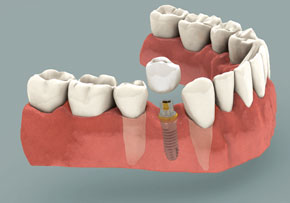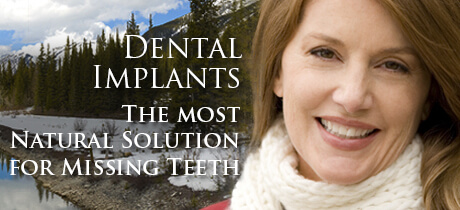Dental Implants

Tooth loss affects more than half of today’s population. Whether it is one tooth or several, lifestyle and appearance can be greatly impacted. Luckily, with dental implants, patients no longer have to sacrifice appearance, function, or durability.
Dr. Budd incorporated dental implants into his practice in 1985, and has had a high rate of success ever since. His focus rests on being versatile and open to treating every case as a unique situation.
This perspective has led him to take advanced training and offer the latest procedures, allowing for more patients to receive the benefit of dental implant treatment.
A leader in the field, Dr. Budd not only takes continuing education himself, but sponsors and lectures at implant courses for other dental professionals. His use of proven, state-of-the-art techniques has made him an expert at performing complicated procedures like the sinus lift and the bone graft.
He believes dental implants are the most natural replacement for teeth, allowing patients to continue living their life without the disturbances caused by other types of tooth loss solutions. For more information, please consult the text below, or do not hesitate to schedule a consultation with Dr. Budd.
Replacing a Missing Tooth
A natural tooth is anchored into the jawbone by its tooth root. Tooth roots attach firmly to the jawbone and keep your teeth stable when chewing solid foods.
Traditionally, if you were missing a tooth or if one needed to be extracted, the healthy teeth on either side of the missing tooth would be cut down and replaced with a three-unit "bridge."
 |
Bridge Teeth are shaved down on either side to anchor the bridge. |
 |
Dental Implant Adjacent teeth are untouched and an artificial tooth root is in place preserving bone structure. |
Dental implants are the modern alternative. Instead of cutting down two perfectly healthy teeth, Dr. Budd inserts a dental implant into the jawbone to replace your missing tooth root. The implant becomes solidly fixed into your jaw bone (osseointegration). Your restorative dentist then places a crown onto this artificial tooth root that looks, feels, and functions like your natural tooth.
Quite simply, dental implants are the most natural replacement for missing teeth.
Replacing Several Missing Teeth
| Dental Implants | Dentures |
 |
 |
| With implants, the bone structure is preserved for a more youthful appearance | Dentures do not anchor in the jaw. Bone loss occurs causing a sunken aged look. |
Traditionally, several missing teeth would have been replaced with a removable partial or full denture.
Dental implants can now be used to anchor partial and full dentures. This prevents the slipping, irritation, and pain associated with "floating" partials and dentures. It also prevents the tedious removal of dentures for overnight soaking and cleaning. Dental implants also eliminate the need for denture adhesives. This allows you to enjoy eating the foods you previously avoided. With dental implants, your partials or dentures are firmly anchored to the jawbone, allowing them to feel much more like natural teeth.
Natural tooth roots and dental implant posts are fixed firmly in your jawbone. When you chew, these tooth roots and posts stimulate the jawbone and prevent it from shrinking. You may have seen a person who looked prematurely old because their jawbone had shrunk after wearing floating dentures. Dental implants help preserve your jawbone and appearance.
Dental Implants Prevent Loss of Jawbone
Dental implants help preserve your jawbone and appearance by preventing loss of jawbone which often occurs when teeth are lost. Dental implants function like natural tooth roots. They stimulate the jawbone when you chew and prevent it from shrinking. You may have seen a person who looked prematurely old because their jawbone had shrunk after wearing floating dentures.
The Success Rate of Dental Implants
After their healing period, the success rate of dental implants is between 94% and 98%. If you are a non-smoker with good oral hygiene, the percentage is closer to 98%.
Does the Procedure Hurt?
It is done under local anesthesia and patients generally experience little discomfort after the procedure.
How Long Will Dental Implants Last?
Dental implants become fixed to the jawbone. Though the life span of a dental implant will vary with each patient, many have lasted for more than 50 years. With good oral hygiene and regular cleanings, dental implants could last a lifetime.
Bone Regeneration
A critical question in determining whether an implant can be placed is, "Is there enough bone to support the implant?" Fortunately, advanced bone regeneration techniques now make it possible to place many more implants than just 10 years ago. For more information on bone regeneration, please see the articles on Ridge Augmentation and Sinus Grafting for Implants.
Am I a Candidate for Dental Implants?
Dental implant treatment typically begins with a visit with your restorative dentist. If they feel dental implants might be possible, they will refer you to a Dr. Budd for an examination and consultation.
Your Dental Team
Once the implant is placed, you will be sent back to your restorative dentist for a crown or replacement teeth. We take pride in working closely with your restorative dentist and achieving the best possible result.
For More Information
The following sites will provide you with more information on dental implants:
- MissingTeeth.org website for the Institute for Dental Implant Awareness (IDIA).
- Academy of Osseointegration - What Are Dental Implants
- American Academy of Periodontology Article:
Dental Implants: Teeth That Look and Feel Like Your Own









